Does Height Influence Men’s Reproductive Success?
The last century has seen people around the world get a lot taller:
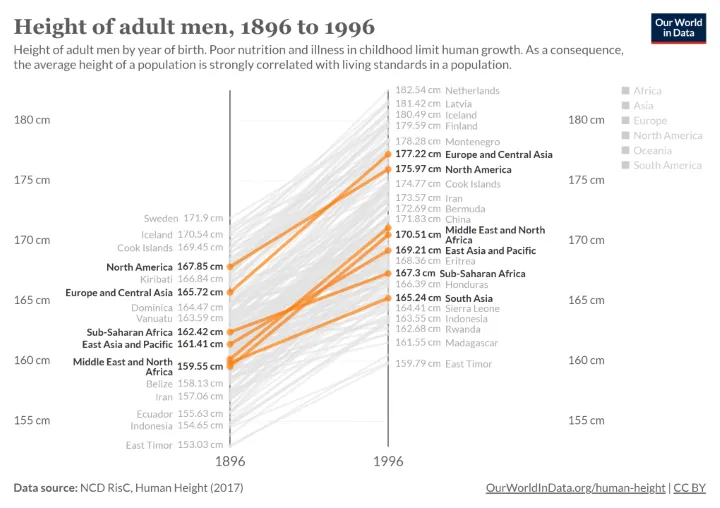
It’s widely known that height rises in tandem with GDP growth and improvements in nutrition and health care. There are some however who would posit that sexual selection has played a significant role in the trend, specifically female selection on male height. This isn’t a completely ungrounded supposition as it is after all the first word in the phrase ‘tall, dark, and handsome’, and women tend to show a preference for taller men (up to a point).
There are plausible reasons to believe that tallness may have been adaptive for men in ancestral environments as it could have given an edge in intra-sexual conflicts and signaled the ability to protect. Height is also associated with social status and resource acquisition. Whatever the nature of this relationship, these attributes have also been traditionally linked to men’s mate value.
While there may be a reasonable theoretical basis for expecting a positive relationship between male height and reproductive success, without any empirical validation it remains in the realm of speculation. Luckily since height is an easily quantifiable metric there is a wealth of research investigating its effects.
What do the studies say
Let’s start with some frequently cited studies. Pawlowski et al. (2000) examined the medical records of 4,419 healthy Polish males aged 25-60 who received compulsory examinations at a medical centre between 1983 and 1989.
It was found that childless men were shorter than men who’d fathered at least one child, and there was an association between height and number of children. They hypothesize that sexual selection on males would have been relaxed following world war two due to a female-skewed gender ratio, explaining why the height and childlessness association was absent among men in their 50s.
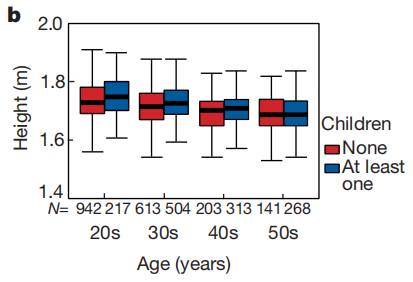
A study by Mueller & Mazur (2001) examined 437 of 539 surviving military officers from the class of 1950 of the United States Military Academy at West Point and found that men in the top height quartile were less childless and had a higher number of offspring, though interestingly it didn’t find an inverse effect of being in the bottom. They determined that it wasn’t that tall men’s wives were more fecund but that they were more likely to start another family with a second wife who was also younger than other men’s second wives on average.
From these results they conclude that there might be ‘unconstrained directional selection for tallness in men’, which will lead to a Fisherian runaway effect until a new race of Nephilim is bred.
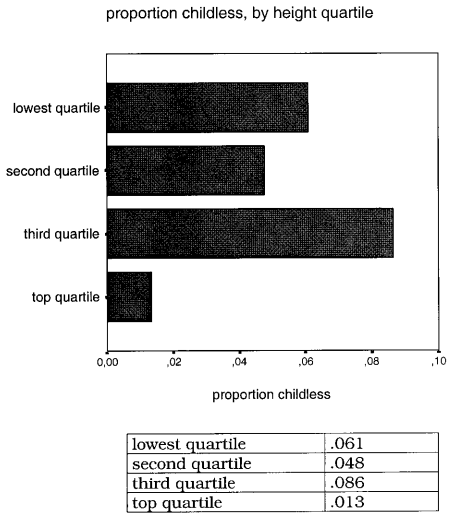
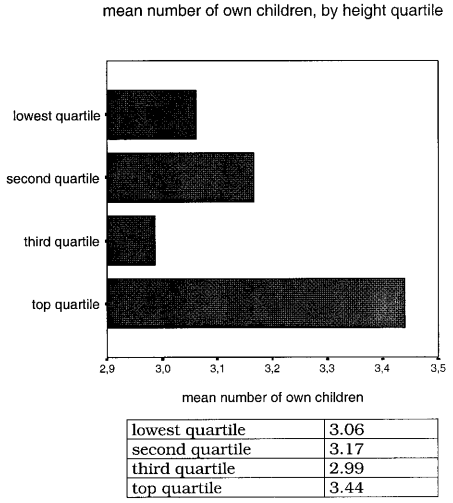
There are several potential concerns with respect to the nature of the sample Mueller & Mazur analyzed. As they note, height requirements at the time were 62-78 inches. While this would cover the vast majority of the height spectrum, it will have left out the outliers which are likely to be under the strongest selection. Still, it seems unlikely that the overall direction and magnitude of the effect would be much changed.
Perhaps more crucially, potential health complications of tall stature (e.g. atrial fibrillation, varicose veins, cellulitis, etc.; Raghavan et al., 2022) may be filtered out due to the medical and physical standards for joining, and these complications may also have a negative effect on desirability and reproductive success. It might even be the case that tall men who do meet the physical requirements are more fit for their height than shorter men who have an easier time doing pull-ups and so on. The Pawlowski et al. sample may suffer from a similar selection bias as it excluded unhealthy men.
These two studies are cited on the ‘scientific black pill’ page on the incel wiki. It says that in addition to Mueller & Mazur study ‘other studies have also confirmed these findings’, but it only provides a citation to the first study as an example. It mentions Nettle (2002) in the section, but doesn’t report its results on reproductive success. So what about those other studies, how consistent a finding really is this?
Vetta (1975) re-analyzed data from a large sample of 2,616 Harvard men for which originally no effect of height was reported.
An inverted U-shaped pattern was revealed whereby both shorter and taller individuals had less children.
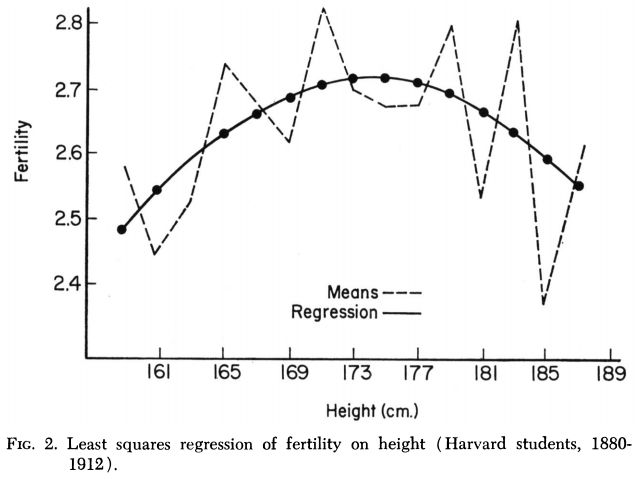
Scott & Bajema (1982) analyzed a sample of 621 males and 610 females from a 1968 follow-up study of the Third Harvard Growth Study, when they were between 50-55.
There wasn’t a significant difference in the mean height of males who had and hadn’t reproduced, or a significant correlation between height and fertility. While non-reproducing males seem to have had a larger SD so more variation, they failed to find a significant curvilinear association.
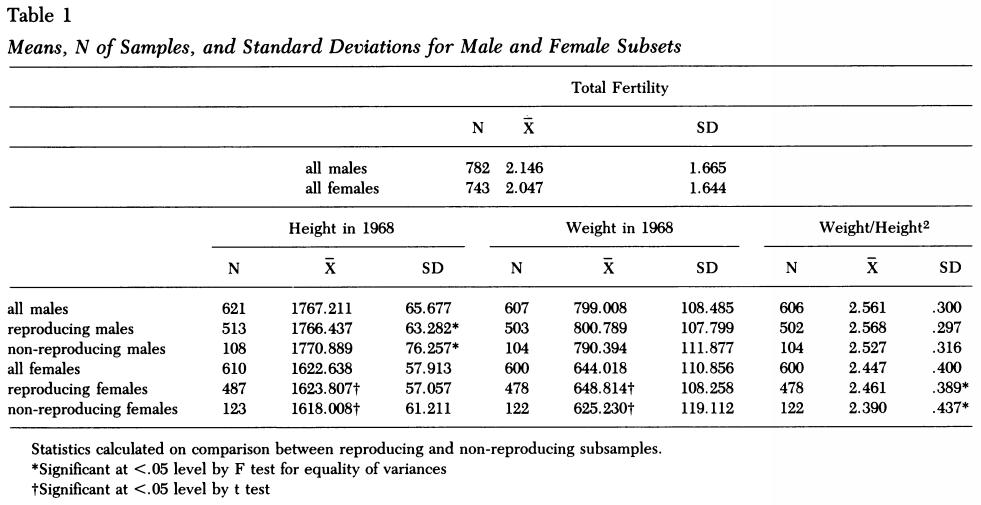
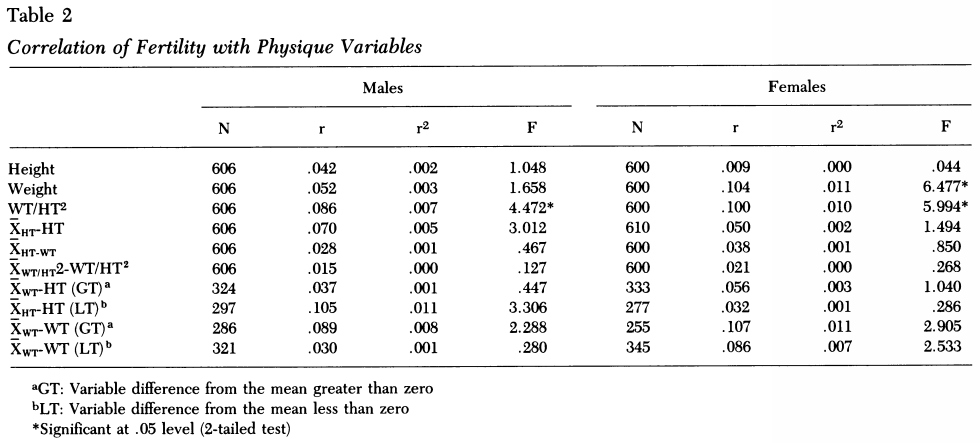
Nettle (2002) analyzed data from the UK National Child Development Study, a longitudinal study which tracked people born in 1958, making them 42 at the time of the study. There were 4,586 men with available height and reproductive data in the 2000 follow up.
Despite being frequently cited as a demonstration of the link between male height and reproductive success, a significant effect neither of height decile nor quartile on number of children was found. If anything, the tallest quartile fathered less children than the others. This may have been related to the fact that tall men were more educated, as fertility was negatively related to educational attainment. To test this the author split the sample up by education and occupational class and still failed to find a significant effect of height other than one in opposite to the expected direction in class III.
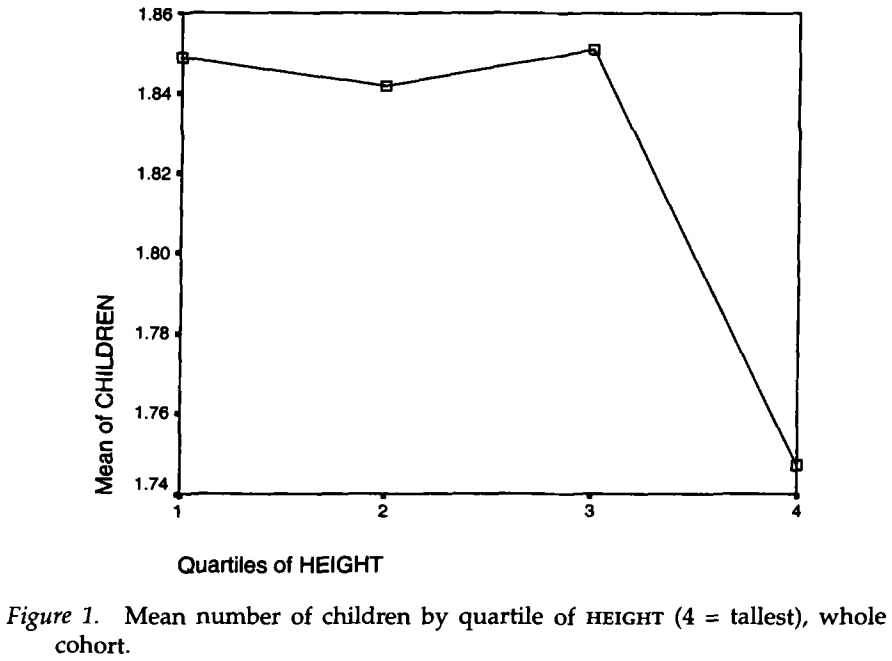
There were though more childless men in the bottom decile (114) than expected by chance (93.5), but this effect wasn’t detected when expanded to the bottom quartile. The top decile was also more likely to be childless, but this effect didn’t quite reach significance.
Prokop & Fedor (2011) found among 499 men above the age of 40 that height was not significantly associated with reproductive success measured either by childlessness or number of children. Unfortunately it seems like they didn’t think to test for curvilinear effects.
Stearns et al. (2012) utilized data of 2,655 men and 2,226 women in the Framingham Heart Study born between 1892 and 1956.
Significant stabilizing selection on male height was observed, as well as a significant negative directional selection on female height (which also seems to be a consistent trend).
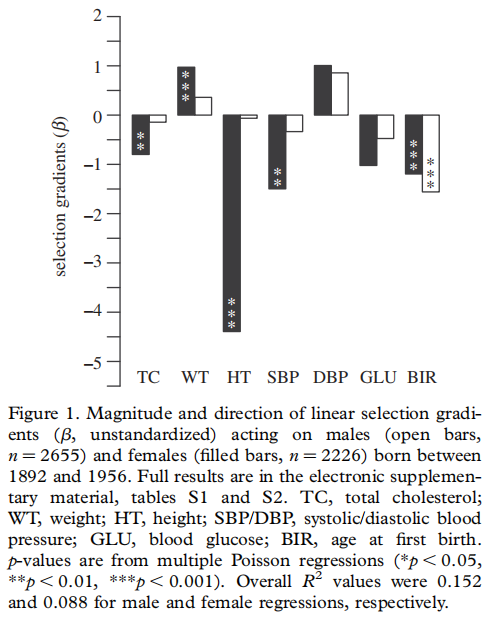
Stulp et al. (2012a) analyzed data from the Wisconsin Longitudinal Study, whose subjects were born between 1937 and 1940. Height data was available for 3,578 men.
There was not a significant linear effect of height on number of children born for men. However, once again this was shown to obscure an underlying quadratic relationship. The optimum height for reproduction was 177.42 cm or about 5’10. Men of average height also married and had their first child youngest. When controlling for age at first marriage, height no longer significantly predicted the reproductive success of married men, so this can at least partially explain the relationship. Controlling for education and income didn’t significantly affect the results however. Height had no relation to the proportion of children born surviving to age 18 or the chance of them marrying.
To give an idea of the magnitude of the effect relative to education and income they compared the change in deviance when removing each variable from the final model. Income’s effect was some 2.8x and education’s 4.5x stronger than that of height. So it seems that even taking this nonlinearity into account height is not a very significant determinant relative to other factors.
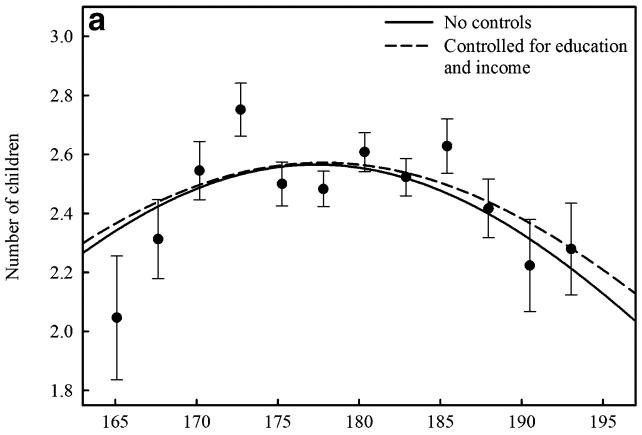
Stulp et al. (2012b) analyzed data from WLS respondents’ siblings. In sibling pairs of average height, male siblings had relatively more reproductive success, and in short sibling pairs the converse.
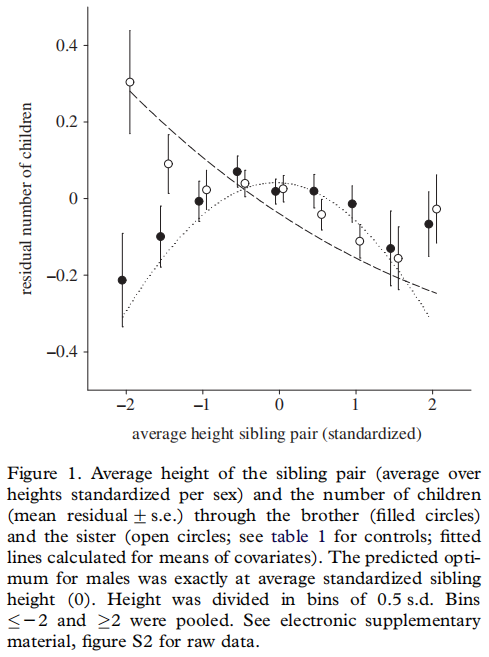
Silventoinen et al. (2013) utilized data from the Finnish Twin Cohort Study, with a final sample of 3,595 male and 4,235 female twin individuals. Surviving participants were 51-59 at the time of the 2009 follow up.
A weak positive but nonsignificant association was found for men. The third quintile (middle) of height had the highest probability of having children. They found a similar association among twin pairs discordant for height which implies that the association isn’t affected by childhood family background.
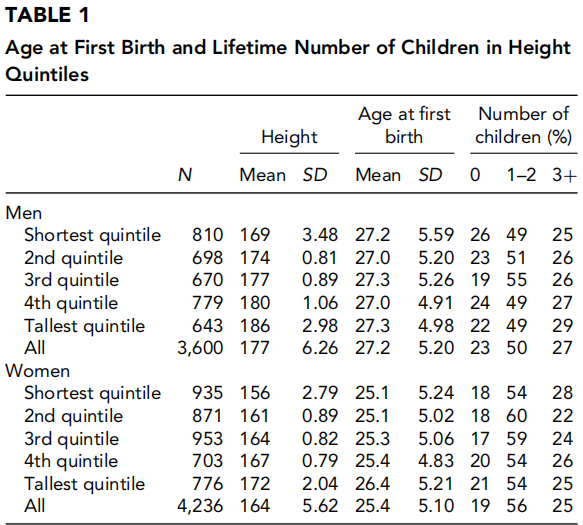
Hugh-Jones & Abdellaoui (2022) looked at data from the UK Biobank of 409,629 White British subjects to measure how polygenic scores of various traits predicted fertility outcomes.
When it came to height, a nonsignificant slightly negative association appeared for men, and a significant negative association for women. They also inferred the effects in their parents’ generation from the subjects’ number of siblings, and it doesn’t seem like the effect of height has shifted at all.
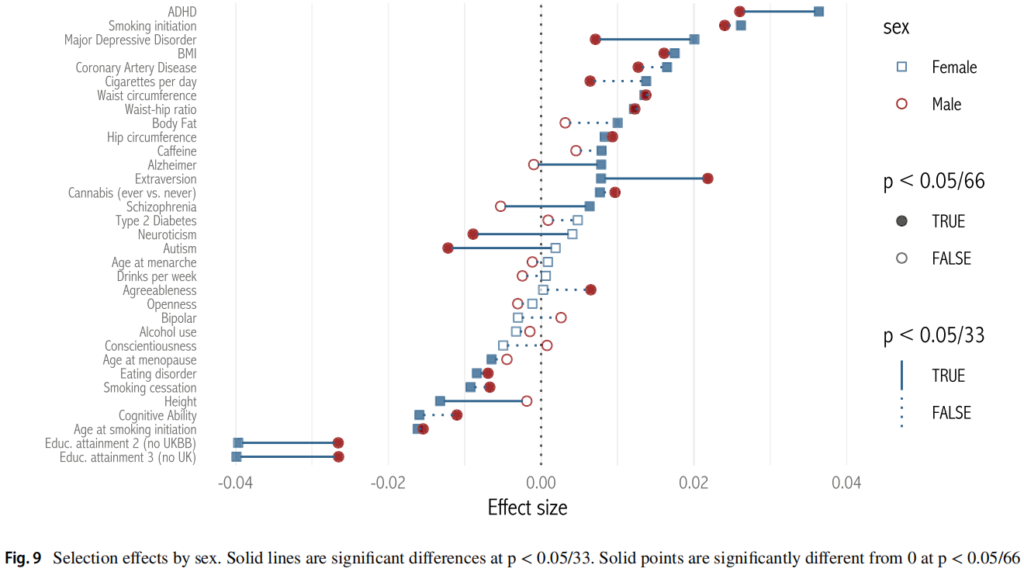
Međedović (2022) found a nonsignificant -.07 association between height and reproductive success (having offspring) among 481 Serbian men with a mean age in the late 20s, and a significant -.07 association among women.
Stulp et al. (2015) looked at a sample of 42,612 Dutch people born between 1935 and 1967. There was a curvilinear effect for men, but this time taller than average men were favoured. The relationship appears to have been partially mediated by education, income, and health. Men who were very tall were more reproductively successful than simply above average height men within their current relationship, but they begin these relationships later.
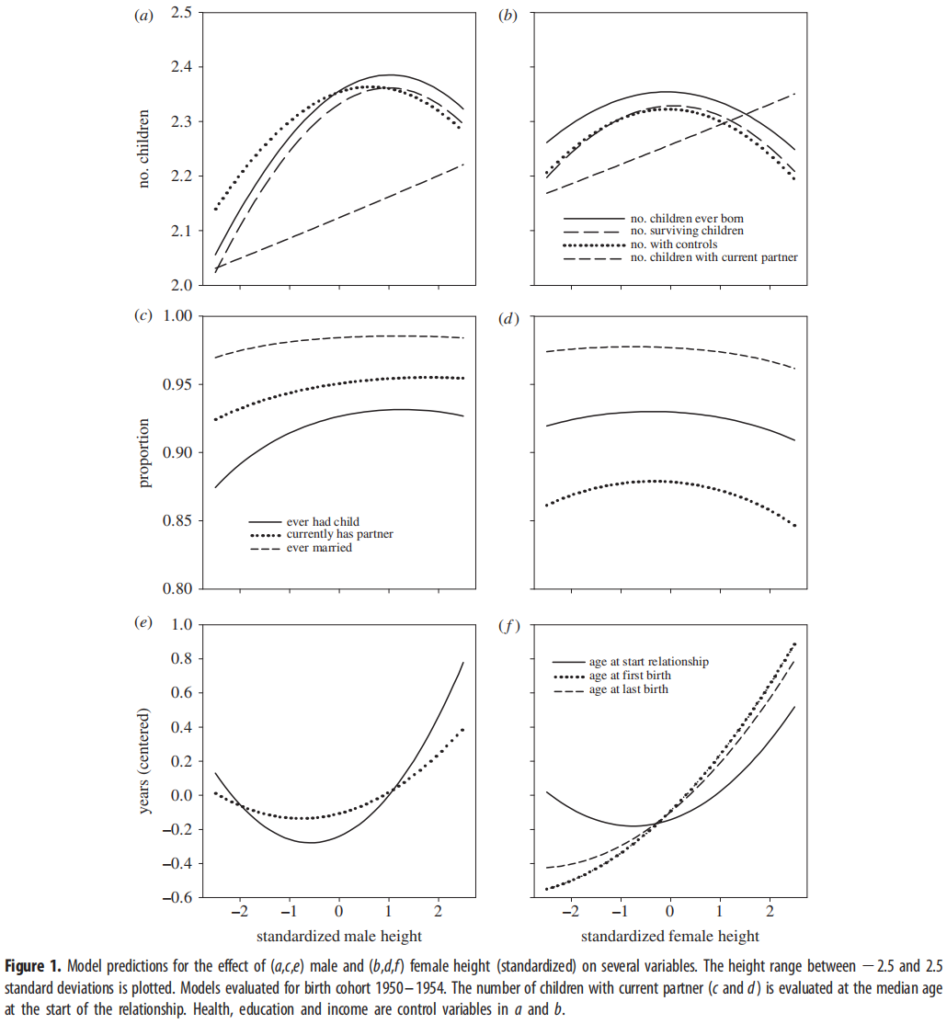
Another study, Thompson et al. (2022), set out to determine to what extent the Dutch secular growth trend was in fact related to fertility outcomes. They note how the sample used by Stulp et al. (2015) was born during a period in which the growth trend was slowing down and it remains unclear whether height was related to fertility outcomes during its peak in the late 19th to early 20th century.
They began with the Historical Sample of the Netherlands, a representative sample born between 1812 and 1922. Then they linked them to their conscription records. Only those born between 1850 to 1900 were included, and those who died before 40 were excluded, for a final sample of 3,396.
Height was curvilinearly related to the risk of being unmarried, with those 0.5 SDs above the mean having the lowest probability, while those who were 2 SDs below the mean had the highest probability. Those more than 2 SDs above the mean also had a higher predicted probability.
Those 0.5 SDs below the mean had actually had the highest predicted probability of having 5-7 children or 8+, with those 2 SDs below or above having the lowest probabilities, representing a curvilinear effect. Height didn’t significantly predict being married and childless, married and having one child, or of being married and having 8+ children relative to the reference group of being married and having 2-4 children. There was though a positive linear relationship between height and the relative risk of having one child and of having 2-4 children. They also found no association between height and infant survival.
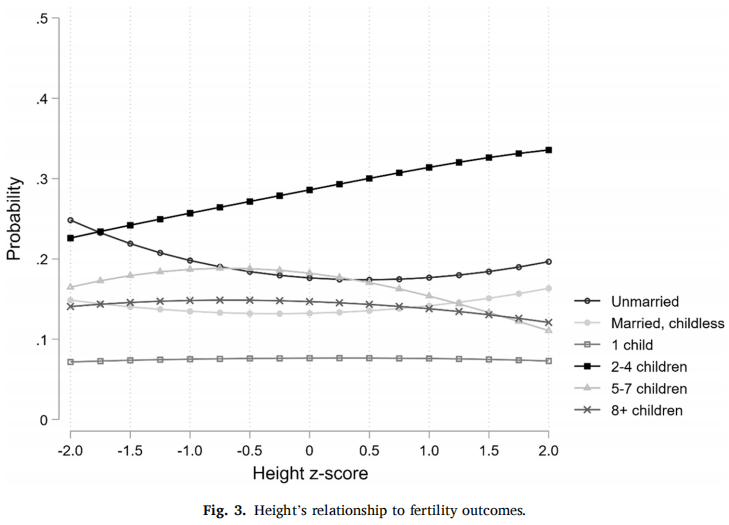
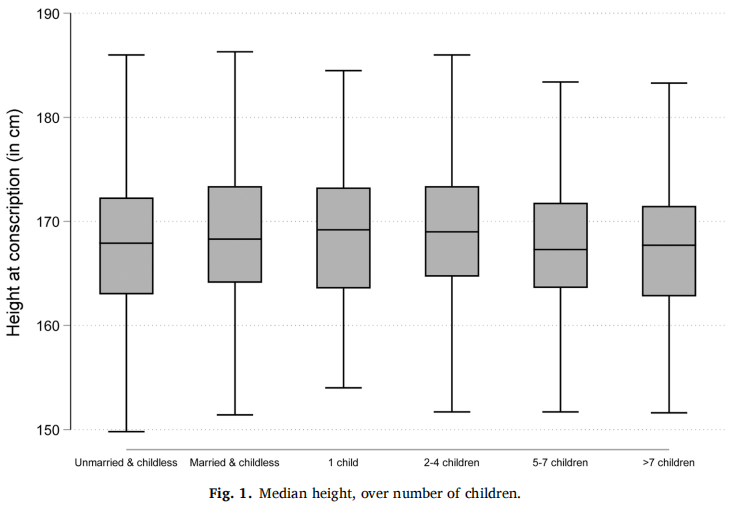
Among the results of a series of simulations, Stulp et al. (2023) found that only the tallest 37% of men would be allowed to reproduce if selection on height were solely responsible for the secular trend from 1850-2000. They conclude that it’s doubtful that selection played a consequential role. Plausible estimates of the strength of selection indicate that it can account for at best .36 cm of the increase in height over six generations. This constitutes a meagre 2% of the 17.2cm total increase. When factoring in the data on historical associations between height, marriage, and fertility reported by Thompson et al., this drops even further to .07 cm, or about .5%. Even these are likely upper bound estimates as for instance differing selection effects on women were disregarded which will have probably reduced or cancelled out altogether the positive selection on male height.
Whatever the case, it looks like the trend has levelled off and may have even begun to reverse:
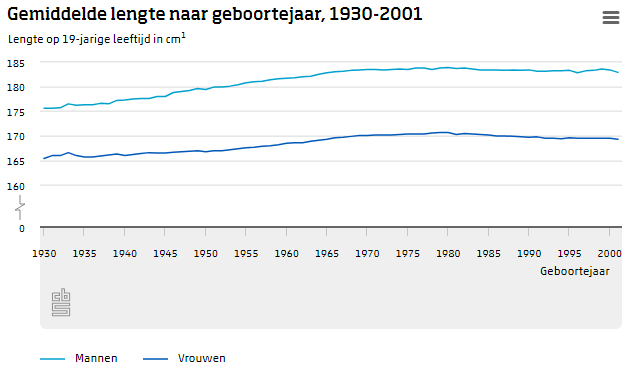
Survey analysis
I also decided to conduct my own analysis on a large nationally representative US survey, the National Survey of Family Growth. Running a simple correlation showed a significant negative relationship between men’s height and number of children of -.05. Running a linear regression model with age, race, educational attainment, and income as control variables negated this association. It seems like education is a negative mediator, while income is a positive mediator (but is less strongly correlated with height than education is).
There was also a negative correlation between height and ever having reproduced, which again disappeared after adding controls.
I tested for a curvilinear effect with a height squared term and found a very small effect, which again disappeared after adding controls.
These graphs of 25-45 non-Hispanic white men and women show similar patterns to most of the previously examined studies with the very shortest and very tallest men and the taller women reporting less children.
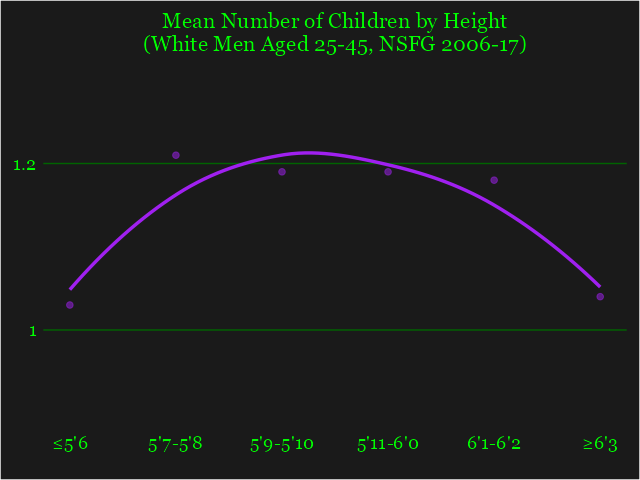
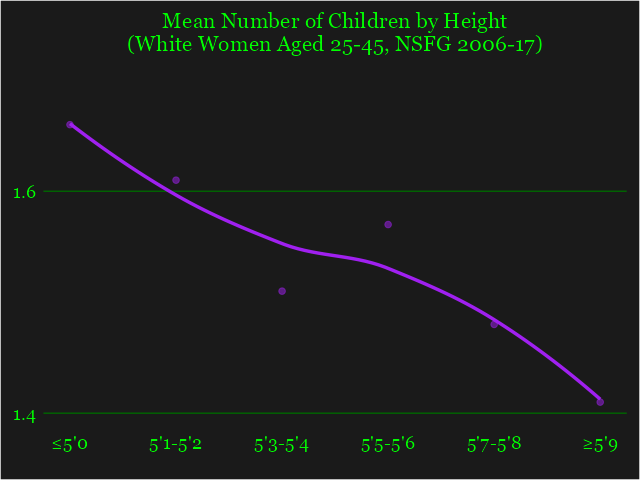
I also checked the GSS and Add Health datasets and didn’t find significant correlations.
Cross-cultural consistency
We’ve seen that in ‘WEIRD’ countries height doesn’t seem to consistently increase men’s reproductive success, what about elsewhere, particularly in higher fertility populations with little in the way of birth control? These societies may be closer to our ancestral environment and may then give a better idea of how things were back then.
Lasker & Thomas (1976) found among Mexican men whose anthropometric measurements were collected in 1948 that there was no significant difference in the stature of those low and high in fertility. The difference in variance wasn’t significant either, though the difference in variance in sitting height was, with more variance seen in the low fertility sample.
Shami & Tahir (1979) found among rural Pakistani population when combining the average range paternal height classes they showed a higher mean number of total siblings than the rest.
Kirchengast & Winkler (1995) compared the reproductive outcomes of men in urban and rural areas of Northern Namibia. It was discovered that men from the city of Rundu without offspring were taller and more robust than those with offspring, while the opposite pattern was found in rural areas. It was hypothesized that this may be because in urban areas the optimal strategy for those higher in socioeconomic status is to have fewer offspring but to invest more in them to minimize mortality risk (‘k-strategy’).
Sear (2006) failed to find a significant correlation between fertility outcomes and height in a sample of rural Gambian men, even though they had a higher number of marriages.
Fielding et al. (2008) in a sample of 2,628 Chinese men ages 50 and up found no relation between any of the physical measures and number of children for men, if anything the trend was for shorter men to have the most children. They had expected that due to personal possessions being highly limited and clothing and ornaments which acted as SES indicators being forbidden that physical characteristics such as height would play a more pronounced role if they were salient to reproductive success.

Tao & Yin (2016) found among an indigenous Taiwanese sample a weak and only marginally significant effect of height on having at least one child and number of children, with 1 cm causing an increase in the probability of having one child by 0.002.
There are a few others but none seem to show a positive relationship.
Explaining the results
It appears that the weight of the evidence points to male height being under stabilizing selection. It is not as folk wisdom tells us being positively selected for. Given that mate preferences studies tend to show women preferring taller (though sometimes average) men, what do we make of this? Could this be a case of ‘look at what they do, not what they say’? It wouldn’t be the first time that stated preferences failed to align with revealed ones.
It might be an oversimplification to say that women prefer tall men. For instance, Gillis & Avis (1980) found that women tended to prefer men 15 cm (6 in) taller than themselves and men women 11.3 cm (4.5 in) shorter. Therefore at least in the case of short women, it may be that they prefer men of around average height, and tall men may prefer women of around average height. This would offer a reproductive advantage to average height men if they were more likely than tall men to pair up with short women who tend to be more fecund. This also seems to be reflected in actual pairings (Stulp et al. 2013).
Similarly, taller men being more likely to pair up with taller women may lower their fertility in turn by taller women tending to be more educated and career oriented (the height and socioeconomic status correlation seems to hold for women too), which leaves less room for child rearing.
As mentioned previously, while increased height tends to carry with it several health benefits, past a certain point it may start to become a liability. Tall men are more at risk of certain cancers such as high-grade prostate cancer (Perez-Cornago et al., 2017), as well as musculo-skeletal issues (Falch-Joergensen et al., 2023). Nettle (2002) found that men in both the top and bottom deciles of height were more likely to have a work-impairing, long-standing illness. These health problems may sometimes pose challenges to relationships. Indeed, these illnesses raised the probability of being childless or having no relationship across the whole sample.
It could also be the case that the life history trade-off between growth and reproduction seen in women also applies to men. As growth is an energy consuming process, growing taller uses energy that could otherwise be directed towards reproduction.
There didn’t seem to be evidence for taller men’s offspring having higher rates of survival which would be a potential offsetting mechanism however.
Intriguingly, while directional selection isn’t consistently found among men, shorter women are consistently found to be popping out the most babies.
Earlier menarche is associated with shorter stature, though some studies controlled for age at the birth of the first child didn’t explain the negative association with fertility, and height still negatively predicted it after women had reached their full height. It may be that the hormonal factors contributing to earlier puberty and shorter stature also raise women’s motivation to have children.
Part of it may be that taller women’s dating pool is self-restricted by their preference for men taller than themselves.
It may be the case that in in modern society short women are less restrained by higher infant mortality rates than in ancestral environments where the reduced infant mortality rate among taller women may have negated the advantage of shortness.
Regardless of the reasons for the particular patterns observed, it should be recognized that the magnitude of the effect is quite small, even in the Pawlowski et al. study showing a positive effect. This indicates that it may not be of too high importance relative to other factors.
Final thoughts
We found that the widely held assumption that tall men spread their seed far and wide doesn’t survive an examination of the wider body of research. This is also consistent with data on sex partners showing a negligible effect of height. It maybe shouldn’t be too surprising that there isn’t much of a connection when sexual dimorphism in body size is relatively minor in humans compared to polygynous mammals in which body size is a strong determinant of reproductive success such as gorillas.
If even in high fertility populations with significant reproductive variance a clear connection between male height and reproductive success is hard to come by then it doesn’t seem promising for the idea that tallness is a universally valued trait. The male-taller norm seems to be far from universal as well, being absent in the Hadza foragers of Tanzania or the previously mentioned Gambian agriculturalists (Sear & Marlowe, 2009).
If there were in fact to be ‘unconstrained directional selection’, this likely wouldn’t last too long either. Not just due to physical constraints, but the genetic variance would end up being exhausted until mutations formed new tallness alleles. The fact that there remains so much genetic variance in height demonstrates that this would have to be a rather recent development.
Since male height isn’t under positive selection but female height seems to be under negative selection and western countries have probably just about hit the ceiling when it comes to the effects of environmental improvements, this will presumably lead to the average height of both genders being dragged down, and a new manlet era will be upon us.
References
Pawlowski, B., Dunbar, R. I., & Lipowicz, A. (2000). Tall men have more reproductive success. Nature, 403(6766), 156. https://doi.org/10.1038/35003107
Mueller, Ulrich & Mazur, Allan. (2001). Mueller, U., Mazur, A.(2001): Evidence of Unconstrained Directional Selection for Male Tallness Behavioral Ecology and Sociobiology 50, 302-311. Behavioral Ecology and Sociobiology. 50. 302-311.
Raghavan, S., Huang, J., Tcheandjieu, C., Huffman, J. E., Litkowski, E., Liu, C., Ho, Y. A., Hunter-Zinck, H., Zhao, H., Marouli, E., North, K. E., VA Million Veteran Program, Lange, E., Lange, L. A., Voight, B. F., Gaziano, J. M., Pyarajan, S., Hauser, E. R., Tsao, P. S., Wilson, P. W. F., … Assimes, T. L. (2022). A multi-population phenome-wide association study of genetically-predicted height in the Million Veteran Program. PLoS genetics, 18(6), e1010193. https://doi.org/10.1371/journal.pgen.1010193
Vetta A. (1975). Fertility, physique, and intensity of selection. Human biology, 47(3), 283–293.
Scott, Eugenie & Bajema, C. (1982). Height, weight and fertility among the participants of the Third Harvard Growth Study. Human biology. 54. 501-16.
Nettle D. (2002). Height and reproductive success in a cohort of british men. Human nature (Hawthorne, N.Y.), 13(4), 473–491. https://doi.org/10.1007/s12110-002-1004-7
Prokop, Pavol & Fedor, Peter. (2011). Physical attractiveness influences reproductive success of modern men. Journal of Ethology. 29. 453-458. 10.1007/s10164-011-0274-0.
Stearns, S. C., Govindaraju, D. R., Ewbank, D., & Byars, S. G. (2012). Constraints on the coevolution of contemporary human males and females. Proceedings. Biological sciences, 279(1748), 4836–4844. https://doi.org/10.1098/rspb.2012.2024
Stulp, G., Pollet, T. V., Verhulst, S., & Buunk, A. P. (2012). A curvilinear effect of height on reproductive success in human males. Behavioral ecology and sociobiology, 66(3), 375–384. https://doi.org/10.1007/s00265-011-1283-2
Stulp, G., Kuijper, B., Buunk, A. P., Pollet, T. V., & Verhulst, S. (2012). Intralocus sexual conflict over human height. Biology letters, 8(6), 976–978. https://doi.org/10.1098/rsbl.2012.0590
Silventoinen, K., Helle, S., Nisén, J., Martikainen, P., & Kaprio, J. (2013). Height, age at first birth, and lifetime reproductive success: a prospective cohort study of Finnish male and female twins. Twin research and human genetics : the official journal of the International Society for Twin Studies, 16(2), 581–589. https://doi.org/10.1017/thg.2012.150
Hugh-Jones, D., & Abdellaoui, A. (2022). Human Capital Mediates Natural Selection in Contemporary Humans. Behavior genetics, 52(4-5), 205–234. https://doi.org/10.1007/s10519-022-10107-w
Međedović, Janko. (2022). The Position of Body Mass in a Network of Human Life History Indicators. Psihologijske Teme. 31. 403-425. 10.31820/pt.31.2.10.
Stulp, G., Barrett, L., Tropf, F. C., & Mills, M. (2015). Does natural selection favour taller stature among the tallest people on earth?. Proceedings. Biological sciences, 282(1806), 20150211. https://doi.org/10.1098/rspb.2015.0211
Thompson, K., Portrait, F., & Lindeboom, M. (2022). Is paternal height related to fertility outcomes? Evidence from the Netherlands during the secular growth trend. Economics and human biology, 47, 101172. https://doi.org/10.1016/j.ehb.2022.101172
Stulp, Gert & Bonnell, Tyler & Barrett, Louise. (2023). Simulating the evolution of height in the Netherlands in recent history. The History of the Family. 28. 1-23. 10.1080/1081602X.2023.2192193.
Lasker, G. W., & Thomas, R. (1976). Relationship between reproductive fitness and anthropometric dimensions in a Mexican population. Human biology, 48(4), 775–791.
Shami, S. A., & Tahir, A. M. (1979). Operation of natural selection on human height. Pakistan journal of zoology, 11(1), 75–83.
Kirchengast, S., & Winkler, E. M. (1995). Differential reproductive success and body dimensions in Kavango males from urban and rural areas in northern Namibia. Human biology, 67(2), 291–309.
Sear R. (2006). Height and reproductive success : How a Gambian population compares with the west. Human nature (Hawthorne, N.Y.), 17(4), 405–418. https://doi.org/10.1007/s12110-006-1003-1
Fielding, Richard & Schooling, Catherine & Adab, Peymané & Cheng, KK & Lao, Xiang & Jiang, Cq & Lam, Tai. (2008). Are longer legs associated with enhanced fertility in Chinese women?. Evolution and Human Behavior – EVOL HUM BEHAV. 29. 434-443. 10.1016/j.evolhumbehav.2008.06.003.
Tao, H. L., & Yin, C. C. (2016). HEIGHT, PARTNERS AND OFFSPRING: EVIDENCE FROM TAIWAN. Journal of biosocial science, 48(5), 593–615. https://doi.org/10.1017/S0021932015000346
Gillis, John & Avis, Walter. (1980). The Male-Taller Norm in Mate Selection. Personality and Social Psychology Bulletin. 6. 396-401. 10.1177/014616728063010.
Stulp, G., Buunk, A. P., Pollet, T. V., Nettle, D., & Verhulst, S. (2013). Are human mating preferences with respect to height reflected in actual pairings?. PloS one, 8(1), e54186. https://doi.org/10.1371/journal.pone.0054186
Perez-Cornago, A., Appleby, P. N., Pischon, T., Tsilidis, K. K., Tjønneland, A., Olsen, A., Overvad, K., Kaaks, R., Kühn, T., Boeing, H., Steffen, A., Trichopoulou, A., Lagiou, P., Kritikou, M., Krogh, V., Palli, D., Sacerdote, C., Tumino, R., Bueno-de-Mesquita, H. B., Agudo, A., … Travis, R. C. (2017). Tall height and obesity are associated with an increased risk of aggressive prostate cancer: results from the EPIC cohort study. BMC medicine, 15(1), 115. https://doi.org/10.1186/s12916-017-0876-7
Falch-Joergensen, A. C., Andersen, P. K., Budtz-Jorgensen, E., Hestbaek, L., Strandberg-Larsen, K., & Nybo Andersen, A. M. (2023). Body height and spinal pain in adolescence: a cohort study from the Danish National Birth Cohort. BMC musculoskeletal disorders, 24(1), 958. https://doi.org/10.1186/s12891-023-07077-3
Sear, R., & Marlowe, F. W. (2009). How universal are human mate choices? Size does not matter when Hadza foragers are choosing a mate. Biology letters, 5(5), 606–609. https://doi.org/10.1098/rsbl.2009.0342

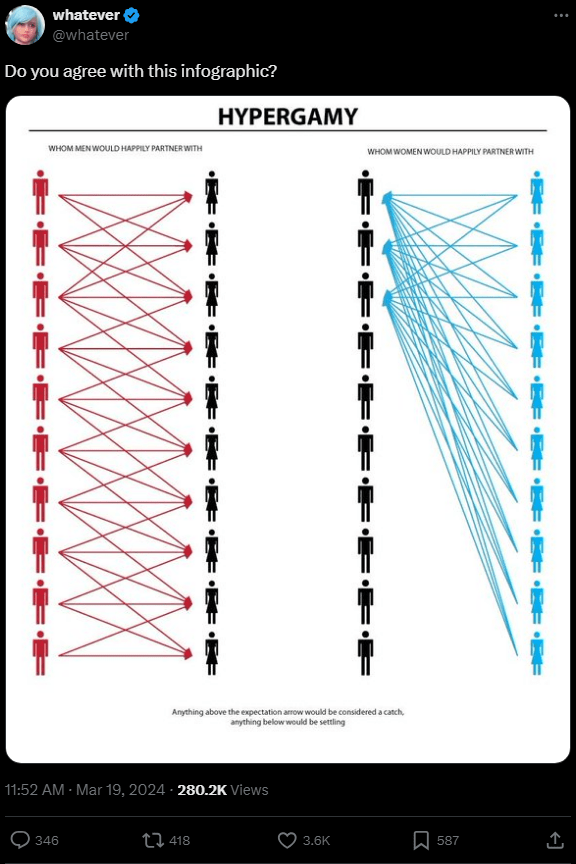
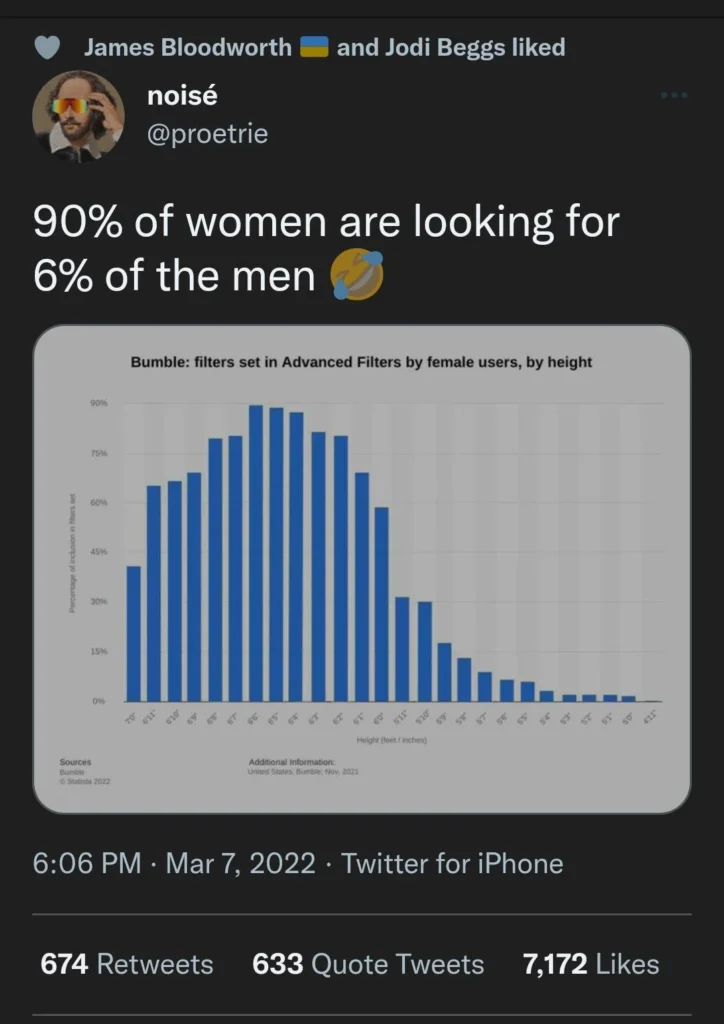
obviously like your website but you need to test the spelling on quite a few of your posts Several of them are rife with spelling problems and I to find it very troublesome to inform the reality on the other hand Ill certainly come back again
Ive read several just right stuff here Certainly price bookmarking for revisiting I wonder how a lot effort you place to create this kind of great informative website
Thank you for the auspicious writeup It in fact was a amusement account it Look advanced to more added agreeable from you By the way how could we communicate
Hey there, I appreciate you posting great content covering that topic with full attention to details and providing updated data. I believe it is my turn to give back, check out my website Webemail24 for additional resources about Search Engine Optimization.
Magnificent beat I would like to apprentice while you amend your site how can i subscribe for a blog web site The account helped me a acceptable deal I had been a little bit acquainted of this your broadcast offered bright clear idea